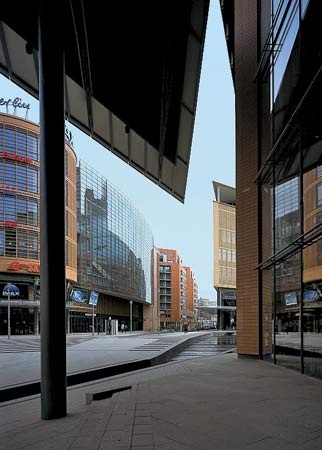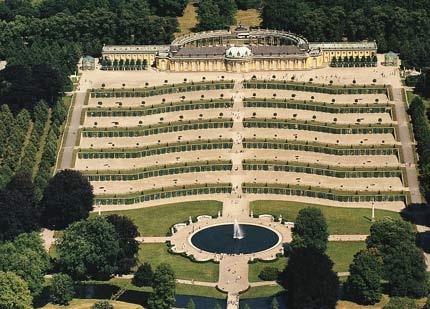Potsdam
Germany
 city, capital of Brandenburg Land (state), eastern Germany. Lying on the southwest border of Berlin, it is sited where the Nuthe River flows into the Havel River, the confluence becoming a series of lakes.
city, capital of Brandenburg Land (state), eastern Germany. Lying on the southwest border of Berlin, it is sited where the Nuthe River flows into the Havel River, the confluence becoming a series of lakes.First mentioned in 993 as a Slavic settlement known as Poztupimi, it received its charter in 1317. It became Brandenburg's electoral residence in 1640 under Frederick William (the Great Elector) and the Prussian royal residence under Frederick II (the Great), during whose reign (1740–86) it was an intellectual and military centre and virtual capital of Prussia. In the 18th century a colony of Dutch immigrants gave their quarter of the city, and some other parts as well, a distinctly Dutch flavour. Potsdam suffered severe damage in World War II, but many monuments survived and others have been restored. The Cecilienhof Palace was the scene (July 17–August 2, 1945) of the Potsdam Conference of the Allied leaders; it now houses a museum and a memorial, as well as a hotel. From 1952 to 1990 the city was capital of the Potsdam Bezirk (district) of East Germany.
 The city was once an industrial centre, but its economy is now dominated by services, including administration, retail, education, film production, and tourism. The incorporated suburb of Babelsburg is a centre of the German film industry. Landmarks include the Sans Souci Palace (1745–47), a masterpiece of German Rococo architecture with grounds that extend for more than 700 acres (285 acres); the Neue Kammern (“New Rooms”; 1747); the Bildergalerie (“Picture Gallery”; 1755–63); the Orangerie (1851–60); and the Neues Palais (“New Palace”; 1763–69). The St. Nicholas Church (1830–37) and the Brandenburg Gate (1770) escaped serious damage during World War II. Potsdam's palaces and their large, beautifully landscaped parks were designated a UNESCO World Heritage site in 1990 (the area covered by the World Heritage site was extended in 1992 and again in 1999). The city is the seat of the University of Potsdam (founded 1991). It is also the site of several observatories and the Max Planck Institutes of Colloids and Interfaces, Gravitational Physics, and Molecular Plant Physiology. Potsdam has army, prehistory, and film museums, and Biosphere Potsdam features some 20,000 plants. Pop. (2003 est.) 144,979.
The city was once an industrial centre, but its economy is now dominated by services, including administration, retail, education, film production, and tourism. The incorporated suburb of Babelsburg is a centre of the German film industry. Landmarks include the Sans Souci Palace (1745–47), a masterpiece of German Rococo architecture with grounds that extend for more than 700 acres (285 acres); the Neue Kammern (“New Rooms”; 1747); the Bildergalerie (“Picture Gallery”; 1755–63); the Orangerie (1851–60); and the Neues Palais (“New Palace”; 1763–69). The St. Nicholas Church (1830–37) and the Brandenburg Gate (1770) escaped serious damage during World War II. Potsdam's palaces and their large, beautifully landscaped parks were designated a UNESCO World Heritage site in 1990 (the area covered by the World Heritage site was extended in 1992 and again in 1999). The city is the seat of the University of Potsdam (founded 1991). It is also the site of several observatories and the Max Planck Institutes of Colloids and Interfaces, Gravitational Physics, and Molecular Plant Physiology. Potsdam has army, prehistory, and film museums, and Biosphere Potsdam features some 20,000 plants. Pop. (2003 est.) 144,979.New York, United States
village and town (township), St. Lawrence (Saint Lawrence) county, northern New York, U.S., on the Raquette River, 30 miles (48 km) east of Ogdensburg. The village was settled in 1803–04 as a cooperative community (disbanded 1810). The State University of New York (New York, State University of (SUNY)) College at Potsdam (founded 1816 as St. Lawrence Academy) and Clarkson University (1896) give it an academic atmosphere.
The town was organized in 1806 and got its name from its reddish sandstone deposits, which were similar to those of Potsdam, Prussia (now in Germany). The quarries, abandoned in 1922, were once important, and Potsdamian was the name given by American geologists to the Late Cambrian (Cambrian Period) and Early Ordovician (Ordovician Period) rock formations. The village was separately incorporated in 1831; part of Norwood village is also in the town. The community has a large dairy industry, several hydroelectric-power developments, and hardwood and paper mills. Area town, 102 square miles (263 square km). Pop. (1990) village, 10,251; town, 16,822; (2000) village, 9,425; town, 15,957.
- Crockett, Samuel Rutherford
- Crockford, William
- crocodile
- crocodile bird
- crocoite
- Crocus
- Croesus
- Crofts, Freeman Wills
- Croft, William
- Croghan, George
- Crohn disease
- Croissy, Charles Colbert, marquis de
- Croix
- Croix de Guerre
- Croker Island
- Croker, John Wilson
- Croker, Thomas Crofton
- Croly, George
- Croly, Herbert David
- Croly, Jane Cunningham
- Cro-Magnon
- Cromarty
- Crome, John
- Cromer, Evelyn Baring, 1st Earl of, Viscount Errington Of Hexham, Viscount Cromer, Baron Cromer Of Cromer
- Cromerian Interglacial Stage